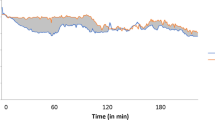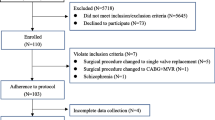Abstract
Purpose
The oxygen reserve index (ORi™) is a parameter used for the noninvasive evaluation of arterial partial pressure of oxygen (PaO2), specifically in the 100–200 mmHg range. We aimed to report on the impact of indocyanine green (ICG) on the ORi™.
Methods
In this study, we retrospectively examined patients who underwent neurosurgery between April and July 2019 and assessed the impact of ICG on ORi™. We excluded patients who did not use ICG or who were not examined for ORi™. The dose and timing of ICG administration were determined by a neurosurgeon. The changes in ORi™ were measured for up to 30 min.
Results
We analyzed ten patients and found that the ORi™ increased to 1.00 in all of them. The median time for ORi ™ to rise to 1.00 after ICG administration was 2 min (range 1–4). After rising to 1.00, ORi ™ decreased and took 27 min to return to the pre-dose value.
Conclusion
It is important to consider the initial rapid increase and subsequent slow decrease in ORi™ when using ICG during surgery.


Similar content being viewed by others
References
Scheeren TWL, Belda FJ, Perel A. The oxygen reserve index (ORI): a new tool to monitor oxygen therapy. J Clin Monit Comput. 2018;32:379–89.
Yoshida K, Isosu T, Noji Y, Hasegawa M, Iseki Y, Imaizumi T, Sanbe N, Obara S, Murakawa M. Usefulness of oxygen reserve index (ORiTM), a new parameter of oxygenation reserve potential, for rapid sequence induction of general anesthesia. J Clin Monit Comput. 2018;32:687–91.
Wang L, Xie L, Zhang N, Zhu W, Zhou J, Pan Q, Mao A, Lin Z, Wang L, Zhao Y. Predictive value of intraoperative indocyanine green clearance measurement on postoperative liver function after anatomic major liver resection. J Gastrointest Surg. 2019. https://doi.org/10.1007/s11605-019-04262-5.
Malagon-Lopez P, Caeeasco-Lopez C, Garcia-Senosiain O, Del-Rio M, Priego D, Julian-lbanez JF, Higueras-Surie C. When to assess the DIEP flap perfusion by intraoperative indocyanine green angiography in breast reconstruction? Breast. 2019. https://doi.org/10.1016/j.breast.2019.07.009.
Schwller MS, Unger RJ, Kelner MJ. Effects of intravenously administered dyes on pulse oximetry readings. Anesthesiology. 1986;65:550–2.
Isosu T, Yoshida K, Oishi R, Imaizumi T, Iseki Y, Sanbe N, Ikegami Y, Obara S, Kurosawa S, Murakawa M. Effects of indigo carmine intravenous injection on oxygen reserve index (ORiTM) measurement. J Clin Monit Comput. 2018;32:693–7.
Reinhart MB, Huntington CR, Blair LJ, Heniford BT, Augenstein VA. Indocyanine green:historical context, current applications, and future consideration. Surg Innov. 2016;23:166–75.
Weiler M, Kassis T, Dixon JB. Sensitivity analysis of near-infrared functional lymphatic imaging. J Biomed Opt. 2012;17:066019. https://doi.org/10.1117/1.JBO.17.6.066019.
Applegate RL 2nd, Dorotta IL, Wells B, Juma D, Applegate PM. The relationship between oxygen reserve index and arterial partial pressure of oxygen during surgery. Anesth Analg. 2016;123:623–33.
Vinary B, Chidananda Swarmy MN, Sunil Kumar HR, Satish R. Effect of indocyanine green dye administration on cerebral oxygen saturation. Indian J Anaesth. 2016;60:64–5.
Ediriwickrema LS, Francis JH, Arslan-Carlon V, Dalecki PH, Brodie SE, Marr BP, Abramson DH. Intravenous injection of indocyanine green results in an artificial transient desaturation by pulse oximetry. Retin cases Brief Rep. 2015;3:252–5.
Jubran A. Pulse oximetry. Crit Care. 2015;9:272.
Acknowledgements
We would like to thank Editage (www.editage.com) for English language editing.
Funding
The authors have no sources of funding to declare for this manuscript.
Author information
Authors and Affiliations
Corresponding author
Ethics declarations
Conflict of interest
The authors declare no conflicts of interest.
Additional information
Publisher's Note
Springer Nature remains neutral with regard to jurisdictional claims in published maps and institutional affiliations.
About this article
Cite this article
Kondo, H., Nakamura, R., Kobatake, A. et al. Effects of intravenous injection of indocyanine green on the oxygen reserve index (ORi™). J Anesth 34, 338–341 (2020). https://doi.org/10.1007/s00540-020-02746-2
Received:
Accepted:
Published:
Issue Date:
DOI: https://doi.org/10.1007/s00540-020-02746-2




